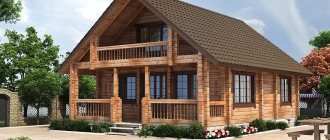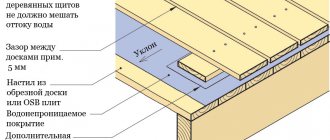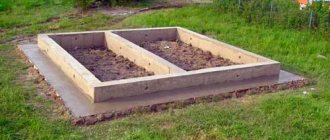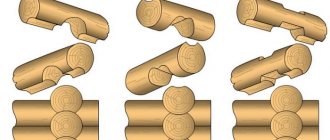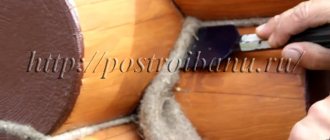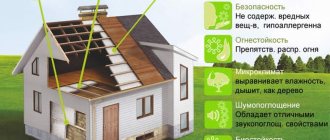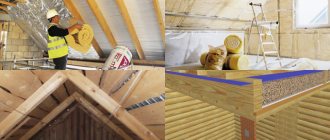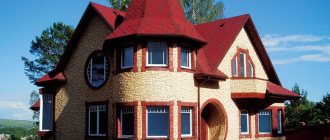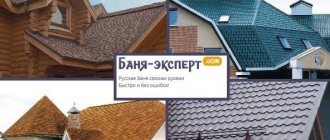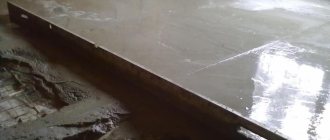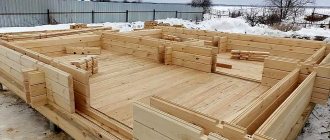Among the many building materials there are the so-called “old-timers,” which include cinder block. It is the progenitor of all modern building blocks, which have recently gained unprecedented popularity. According to production technology, this material is obtained through the process of vibrocompression of a solution in a special form.
In this article you can find a comparison of foam block and gas block.
It contains slag, waste from coal combustion, ash, crushed stone screenings, sand, gravel, sawdust and many other things that are found in the region of your residence. It is noteworthy that you can produce cinder blocks yourself; if you had the desire and a small amount to purchase equipment and components for the solution.
General information
Cinder block is a material that is made by vibrocompression of concrete mortar; it has a rectangular shape with technological voids inside (up to three) of various shapes, a standardized size of 18.8x19x39 cm.
There are blocks without voids - they are called solid. They are much less common, since hollow cinder blocks are cheaper and have better thermal and sound insulation characteristics. The volume of voids does not exceed 30% of the total volume of each unit.
You can often hear that if you use the highest quality cement when making cinder blocks, then you can build a reliable foundation for a bathhouse or house from homemade blocks. But this is not true, because the foundation blocks must withstand heavy loads. Therefore, we recommend that for the construction of a bathhouse or residential building, you still purchase raw materials from a specialized construction market or replace them with foam blocks.
When making cinder blocks at home, you will need a special mold, ideally made of metal, in order to use it several cycles in a row, and a special vibrating machine. It is also best if you have a drawing of the blocks themselves, because without it you may end up with something completely different from what you originally wanted.
If you wish, you can change the parameters of the standard drawing, depending on the type of building and the goal you want to achieve.
To produce at home you will need:
- Coarse sand;
- Blast furnace slag or fine screening of crushed stone, crushed expanded clay;
- Cement grade not lower than M400;
- Vibrating table and vibrating machine;
- Mold for cinder block.
On average, one bag of cement is enough to produce 36 standard size cinder blocks.
The most important characteristic of a quality material is its geometry. They must have perfectly smooth edges, otherwise, if there are defects, irregularities, etc., it will be impossible to lay them. To achieve ideal geometry, it is necessary to pour the solution into the mold not just to the brim, but with a small “hill”, since the solution will shrink a little when vibrating.
Implementation
Before you decide to open a business and buy a machine for producing cinder blocks, you need to determine what your target audience will be. Such people can be citizens who have planned to build a summer house, garage, shed or some other small building on their own, without the involvement of specialist builders.
Next, you will be required to register your business activity, as well as choose a unified taxation system. After this, you as a businessman will pay a fixed amount of tax in absolute terms. You will not be required to make any complex calculations of various taxes and fees.
If you have already found a premises for production and storage, bought all the necessary equipment and inventory, then you should start recruiting qualified and responsible workers. It is necessary to pay attention to the design of the sign for the established company, as well as advertising.
Mixing the solution
First, you need to understand that there is no ideal recipe for mixing the solution. Every master has the power to change the ratio of the ingredients included in the composition, but if this is your first time creating cinder blocks with your own hands, then you should stick to the standard composition:
- 7 parts slag;
- 2 parts of sand or gravel fraction 0.5-1.5 cm;
- 1.5 parts of cement grade M400 or better M500;
- 2-3 parts water;
As the main filler, instead of blast furnace slag, you can use expanded clay, clay, gypsum, gravel, perlite and many other analogues. But there is one important rule - if slag is chosen as the main filler, then adding other additives is strictly not recommended.
Particular attention is paid to the amount of water in the mixture. The solution should not turn out too liquid or vice versa.
You can also add 5 grams of plasticizer per block to the mixture, which will help increase thermal performance and protect the material from moisture and low temperatures.
If you would like to get colored cinder blocks, then you can add a little chalk or crushed brick to the solution.
To check the quality, you can do a simple test: take a little solution in your hand, crumple it into a ball and throw it on a flat surface. If it crumbled due to a collision, but when compressed again it regained the shape of a circle, such a mixture can be safely used in construction.
Applications and types of cinder blocks
Now this building material is more often used in the construction of non-residential buildings: garages, sheds, swimming pools, outbuildings, fences. This is due to the characteristics of the cinder block.
There are several types of material:
- Solid, wall. These are durable blocks that are used to create building structures and load-bearing walls.
- Full-bodied, foundational. Used when laying foundations. They are durable, have increased strength, do not shrink, and the material does not crumble.
- Hollow. They have internal voids. Cheaper, but less durable. Needed for interior walls and partitions.
- Facing. They have a decorative coating and texture on one side. Used for finishing walls and fences on the front side.
Manufacturing technology
In the case when you are not planning large-scale construction work, the construction of a multi-story building, and so on, the blocks can be created without vibration compaction.
Assembling the form
Assembling the mold is not a difficult process. The form is made of wood or metal, its dimensions must correspond to the dimensions of the future cinder blocks, on average it is 40x20x20 or 39x18.8x19 cm.
The structure consists of a bottom and side walls. The edges of the mold are made from sheets of metal 5-6 mm thick. The walls are welded together or notches are made in the transverse and longitudinal walls with a grinder, with the help of which they are attached.
If desired, and also to speed up the process, you can assemble a form with several cells 2,3,4 and even 6 or 8. To do this, it is enough to increase the length and width of all edges and install additional partitions between the cells.
To create hollow blocks, cylinders made of wood or metal, usually 2-3 pieces, are attached to the bottom using ordinary hardware (screws or nails). To save money and make your work even easier, you can use regular empty bottles instead of cylinders.
If you use wood as the walls of the mold, then they must be painted with oil paint so that the solution does not stick to the wood.
Production using a mold
Ideally, for the cinder block production process, find a secluded room with a good ventilation system, a flat floor and dry air.
Step-by-step instructions for producing blocks using a mold:
- To begin with, all prepared components must be placed in a concrete mixer, adhering to the proportions indicated above.
- When the solution is ready, fill the form with it. In order to create voids in the thickness of the blocks, bottles are placed inside the mold with the neck up, usually two or three, pre-filled with water.
- The mixture is carefully compacted so that it fills all the voids and removes air bubbles, because the more air the block contains, the less quality and reliable it is.
The solution is left for 5-6 hours, after which the bottles are removed, and the blocks themselves are left in the mold for another day. Afterwards, the blocks are taken out and stored in stacks in a dry place inaccessible to sunlight. They are dried for 28 days so that the solution completely hardens and gains its ultimate strength.
In order to prevent cracking and other deformations, the blocks should be sprayed with a small amount of water for the first few days, after which they should be wrapped in a layer of plastic film.
Production using a vibrating machine
A vibrating machine makes it possible to speed up and facilitate the process of producing cinder blocks significantly, but the price for such a unit is quite high. Therefore, for one-time use, it is better not to buy a machine or assemble it yourself, although in this case you will need certain knowledge in electrical and engineering.
The price of a machine depends on three main factors: manufacturer, power and productivity.
Here are 3 simple steps to make blocks at home using a vibrating machine:
- The mixture is mixed in the required proportions in a concrete mixer.
- The solution is filled into a mold with a small slide. After that, the vibrator is turned on for 5-10 seconds, the solution settles. The procedure is repeated until the clamp settles on the limiter.
- Then the machine is turned on again for 10-15 seconds, and the mold is removed without turning off the unit.
Within a week (5-7 days), the blocks are dried, and their complete hardening occurs no earlier than after a month.
If you have added a plasticizer to the composition, then within a few hours (7-8) after removing the blocks from the mold they can be transported and stored.
Cinder blocks are stored in pyramidal stacks of up to one hundred units in each stack.
Necessary equipment
As in any other business, in this case you need certain equipment for the production of cinder blocks. And here we can name the following necessary units:
— forced-type concrete mixer;
— machine for the production of cinder blocks “Comanche” (2 pieces);
— a wheelbarrow necessary to deliver the solution to the machine from the concrete mixer;
- container with water;
- buckets, shovels, troughs, spatulas, as well as other auxiliary equipment.
The production of cinder blocks is most often carried out using a Comanche-34 brick press. This device can also be used for other wall stones and blocks produced by vibration pressing. This installation is characterized by a productivity of approximately 120 blocks per hour. The dimensions of the cinder blocks in this case will be 390*190*190 millimeters. The brick press operates from a standard power supply. The list of advantages of this particular model includes ease of maintenance and repair, low cost, reliability, high and quick payback.
Tips from the master
- Blocks made with the addition of cement are stronger and more durable. Lime blocks cope with loads a little worse.
- During drying, the blocks should not be placed close to each other. This can only be done after the solution has completely dried.
- If you replace small granules with sand, the technical characteristics of such a material will only increase.
- If you want to save money, you can combine cement and lime in a ratio of 3 to 1. This will not affect the quality in any way.
- Remember, the thicker the solution, the faster the block will dry.
- Immediately before pouring the mold, it must be cleaned and wiped. To do this, use diesel fuel, used engine oil, and so on. This manipulation will prevent the solution from sticking to the matrix.
Despite the fact that wood and brick are leaders in the construction markets, many craftsmen have learned to save money by producing inexpensive but high-quality material - cinder block. Owners of summer cottages are attracted by the simple production technology. A machine for making cinder blocks at home can be bought at any construction market. By adhering to the recipe, you can easily produce blocks of fairly decent quality in a short time.
Assembling the machine base
To make the base you will need a profile 4 mm thick. and a pipe. The profile is used to make a support frame onto which the wheels are mounted. Two vertical posts are welded to the support frame, along which the cinder block mold will move on sliders. At the top, the racks are connected to each other by a pipe, which will serve as both a handle for the operator and a support for the lifting mechanism.
The lifting mechanism is a rectangular frame made of a profile, which is attached to the transverse pipe using rotating bushings. The frame itself is connected to the form using chains from a motorcycle or moped.
An electric motor with two shafts is attached to the mold, at the ends of which an eccentric system is installed. When the electric motor is turned on, the mold will vibrate, compacting the loaded material.
The design works as follows. The form is placed on the platform and filled with the prepared solution. It is then covered with a lid and pressed down with the weight of the operator. At this moment the electric motor starts. Its operating time is determined by the weight of the operator and the consistency of the base solution. After which the form is lifted by the mechanism, and the structure is moved to a new location.
Video using the above machine for making cinder blocks
We recommend other articles on the topic
Silicone sealants for external and internal seams, plumbing sealants
Fireclay clay - selection and use of refractory clay
Volma layer gypsum plaster - technical characteristics, instructions for use
Bark beetle plaster: application technology, consumption per 1 m2
Main characteristics of cinder blocks
One of the main parameters of cinder block stone is its strength grade. The parameter value ranges from 35 to 125. Indicates the maximum weight (in kg) that the material can bear per 1 square meter. cm (35-125 kg).
- Cinder block grade M35 is the most fragile and is used for insulation.
- M50, M75 are needed for the installation of partitions and internal walls.
- M100, M125 are considered the most durable and are used when laying foundations and load-bearing walls. Accordingly, the larger the number in the cinder block grade, the greater the load it can withstand.
Frost resistance is assessed in cycles: 15-50. The higher the value, the better the stone can withstand low temperatures. In central Russia, cinder block is used at 35, in the northern regions of the country - at 50.
The thermal conductivity coefficient of slag concrete is 0.27-0.65 W/m*K.
